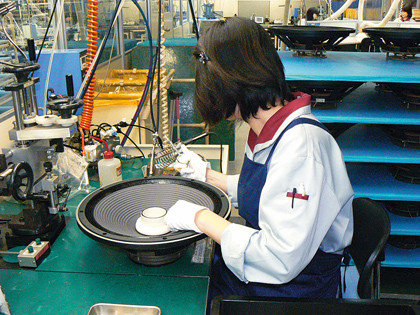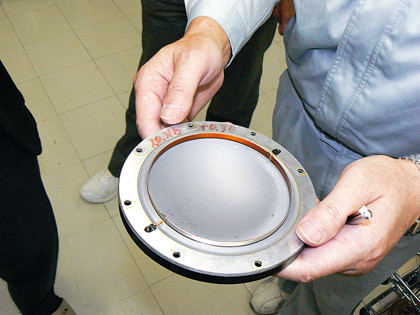Even though speakers have been coming off the production line since 1966, virtually no media has been invited to tour the facility.
Determined to learn more about Pioneer's elusive megaspeakers, Home Cinema Choice magazine's Steve May eventually secured exclusive access, and trekked to Pioneer's remote Tohoku plant in rural Tendo, Japan to see where TAD speakers come to life.
Within its gates we found a small team dedicated to making these gargantuan boxes. Indeed, the speakers themselves are crafted by a mere handful of workers, some of whom been wrapping the same voice coils and assembling the beryllium drivers for more than 20 years.
'This is a specialised job,' said Takashi Suziki, the speaker division's GM. 'Even inside Pioneer, very few know how to make these speakers.' Mie Suzuki, who has been assembling and testing TAD speakers since the early 1990s, explains: 'A single operator conducts the assembly of each unit one by one, from start to finish. While there is a fair amount of stress and responsibility, the job is worthwhile.'
I dare say that professional sound engineers around the world would tend to agree.
Actually, the TAD production line is just a small part of the Tohoku operation. Elsewhere in the facility, speakers are produced for Pioneer's Carrozeria in-car brand, while R&D teams scrutinize everything from OEL displays to the latest innovations in mechatronics.
And somehow fittingly, the influence of the past still impacts on the brand's forward-thinking tech; close to the plant is the Tohoku Pioneer Museum of Automatic Music Instruments, an impressive, extensive collection of antique music boxes dating from the 19th century.
Sign up for breaking news, reviews, opinion, top tech deals, and more.
A passion of Pioneer's founder Nozomu Matsumoto, these are masterpieces of intricate engineering – just like the TAD R1s.

Mie Suzuki has been making TAD speakers for over a decade. She's part of a small team responsible for some of the world's biggest hi-fi kit
1. Here the voice coil – an aluminium ribbon wire insulated in alumite film – is attached to a TD-2001 high-frequency driver. The ribbon is hand-wound onto a bobbin formed from a high-polymer compound that's heat resistance up to 400ºC, providing a tolerance for high-energy input levels.

2. After attaching the voice coil to the bobbin, any excess glue is carefully wiped away…

3. Here, a voice coil wire is soldered to the lead wire on a TAD TL-1603 low frequency speaker. The TL-1603 is designed to work with a maximum input of 500W.

4. A pure beryllium diaphragm is used to make the TD-2001 driver. It's designed to give an extremely flat frequency response with outstanding transient response and high-fidelity imaging. Here, the voice coil assembly goes through final adjustment.

5. Every component in a TAD Reference One speaker has been optimised for performance, making the models a favourite of sound engineers worldwide.

6. A voice coil is attached to a TD-4001 rear -compression driver and cleaned. One of the world's most lauded speaker designs, it can deliver stunning audio clarity.
